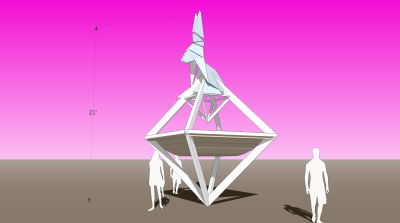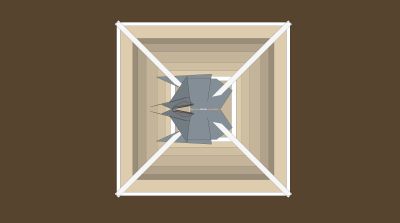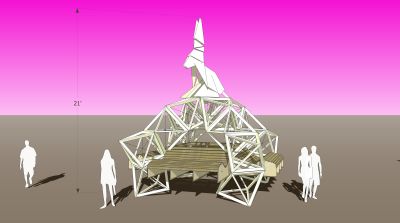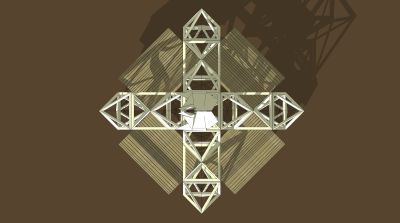Difference between revisions of "Temple of the Paper Rabbit"
| Line 1: | Line 1: | ||
An installation by Geodesic Temple in sync with Disorient's 2023 theme: [[2023 Year of the Paper Rabbit|the year of the Paper Rabbit]]<BR> | An installation by Geodesic Temple in sync with Disorient's 2023 theme: [[2023 Year of the Paper Rabbit|the year of the Paper Rabbit]]<BR> | ||
==Statement== | |||
Amidst the intricate folds of a paper rabbit lies a thought-provoking paradox: an object of fragility yet imbued with a quiet resilience. The Temple of the Paper Rabbit (TOPAR) invites us to contemplate the essence of existence and the inherent duality of our human experience. Through the delicate craftsmanship and imaginative playfulness of the paper rabbit, we are reminded of the power of art to reveal the hidden depths of our souls, and to illuminate the beauty and mystery of the world around us.<BR> | |||
===The Rabbit=== | |||
The choice of the paper rabbit reflects the cultural significance of this symbol, the community-building potential of collaborative art, and the deeper themes of transformation and resilience associated with it. The Year of the Rabbit in the Chinese zodiac adds to its cultural significance. The use of a collaborative approach to create the sculpture reinforces the sense of community and interconnectedness among the people involved. The artwork becomes a metaphor for the human experience, reflecting our fragility and resilience in the face of life's challenges. | |||
===The Paper Fold=== | |||
The concept of fold can be understood in various ways, depending on the context in which it is being used. At its most basic level, a fold refers to a bend or crease in a material, such as paper or fabric, that creates a change in direction or shape. In the context of TOPAR, the concept of fold takes on a deeper significance.<BR> | |||
The act of folding paper is a form of transformation, where a two-dimensional surface is transformed into a three-dimensional form. This transformation is a powerful metaphor for the transformative nature of art itself. Art has the power to take us out of our everyday reality and transport us to new worlds and new perspectives. In this way, art is like a fold that changes the shape of our understanding of the world around us.<BR> | |||
The idea of a fold can also be seen as a symbol of duality or paradox. When we fold a piece of paper, we create two distinct planes that are connected to each other. In the same way, our human experience is often characterized by a duality or tension between opposing forces, such as light and darkness, pink and orange, or life and death. This tension is what gives meaning and depth to our lives and to the art that reflects our experiences.<BR> | |||
Finally, the concept of fold can also be seen as a metaphor for the fragility of life. Like a paper rabbit that can easily be torn or damaged, our lives are inherently fragile and vulnerable. Yet, like the paper rabbit, we also possess a resilience and strength that allows us to endure and overcome the challenges that we face.<BR> | |||
Overall, the concept of fold in the context of TOPAR is a rich and multi-layered concept that speaks to the transformative power of art, the duality of our human experience, and the fragility and resilience of life itself.<BR> | |||
<!-- | |||
===On the use of plywood=== | |||
The fact that the paper rabbit sculpture is made of plywood rather than paper does not necessarily diminish the value or meaning of the artwork. In fact, it can be argued that the use of wood, a material that is stronger, more durable than paper and from which paper is extracted, adds to the artwork's meaning and significance.<BR> | |||
At its core, art is about the communication of ideas and emotions through creative expression. The choice of materials used in an artwork is just one aspect of that expression. While the artwork may be called a paper rabbit, the fact that it is made of plywood instead of paper does not fundamentally change the artist's intention or the message that the artwork is meant to convey.<BR> | |||
Moreover, the use of plywood in the sculpture can be seen as a commentary on the relationship between reality and representation. In the same way that the plywood sculpture represents a paper rabbit, our perceptions of reality are often mediated through representations and symbols. The use of plywood in the artwork can therefore be seen as a reflection of the ways in which our understanding of the world is constructed through symbols and representations.<BR> | |||
Ultimately, what is important is not the material used in the artwork, but the message and emotion that the artwork conveys. The fact that the artwork is a representation of a paper rabbit rather than a rabbit made of paper does not detract from its value as a work of art, but rather adds to its complexity and depth. As viewers, we are invited to reflect on the relationship between reality and representation, and to contemplate the ways in which our perceptions of the world are shaped by symbols and meanings.<BR> | |||
--> | |||
==Preliminary drawings== | ==Preliminary drawings== | ||
Revision as of 06:16, 30 March 2023
An installation by Geodesic Temple in sync with Disorient's 2023 theme: the year of the Paper Rabbit
Statement
Amidst the intricate folds of a paper rabbit lies a thought-provoking paradox: an object of fragility yet imbued with a quiet resilience. The Temple of the Paper Rabbit (TOPAR) invites us to contemplate the essence of existence and the inherent duality of our human experience. Through the delicate craftsmanship and imaginative playfulness of the paper rabbit, we are reminded of the power of art to reveal the hidden depths of our souls, and to illuminate the beauty and mystery of the world around us.
The Rabbit
The choice of the paper rabbit reflects the cultural significance of this symbol, the community-building potential of collaborative art, and the deeper themes of transformation and resilience associated with it. The Year of the Rabbit in the Chinese zodiac adds to its cultural significance. The use of a collaborative approach to create the sculpture reinforces the sense of community and interconnectedness among the people involved. The artwork becomes a metaphor for the human experience, reflecting our fragility and resilience in the face of life's challenges.
The Paper Fold
The concept of fold can be understood in various ways, depending on the context in which it is being used. At its most basic level, a fold refers to a bend or crease in a material, such as paper or fabric, that creates a change in direction or shape. In the context of TOPAR, the concept of fold takes on a deeper significance.
The act of folding paper is a form of transformation, where a two-dimensional surface is transformed into a three-dimensional form. This transformation is a powerful metaphor for the transformative nature of art itself. Art has the power to take us out of our everyday reality and transport us to new worlds and new perspectives. In this way, art is like a fold that changes the shape of our understanding of the world around us.
The idea of a fold can also be seen as a symbol of duality or paradox. When we fold a piece of paper, we create two distinct planes that are connected to each other. In the same way, our human experience is often characterized by a duality or tension between opposing forces, such as light and darkness, pink and orange, or life and death. This tension is what gives meaning and depth to our lives and to the art that reflects our experiences.
Finally, the concept of fold can also be seen as a metaphor for the fragility of life. Like a paper rabbit that can easily be torn or damaged, our lives are inherently fragile and vulnerable. Yet, like the paper rabbit, we also possess a resilience and strength that allows us to endure and overcome the challenges that we face.
Overall, the concept of fold in the context of TOPAR is a rich and multi-layered concept that speaks to the transformative power of art, the duality of our human experience, and the fragility and resilience of life itself.
Preliminary drawings
Version: 20230330
Version: 20230329
Version: 20230328
Dimensions: 15' x 15' x 17'
Weight: TBA Lbs
Colorway: white on white
Lights: Pink LED spotlights: pink on one side, white on the other.
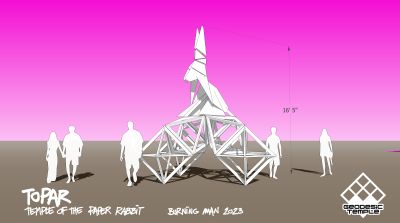
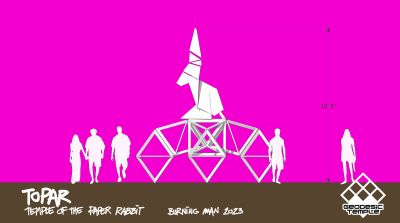
Rabbit/OH connection
Use octahedron studs as structure for Rabbit element made of plywood skin
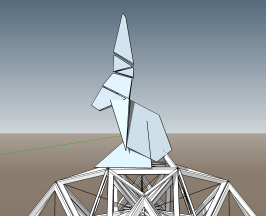
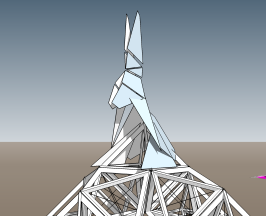
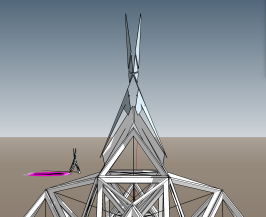
Templars
Direction: The Eye
Rabbit fabrication: Pinky
FB | Discord | Library | System <-----  -----> info@geodesictemple.com
-----> info@geodesictemple.com
